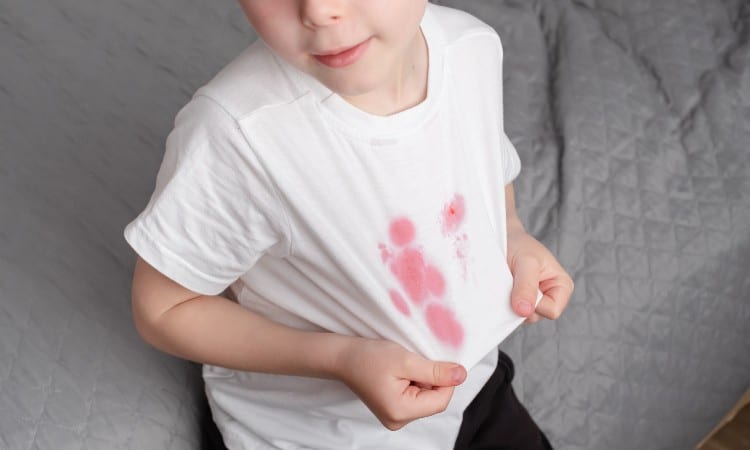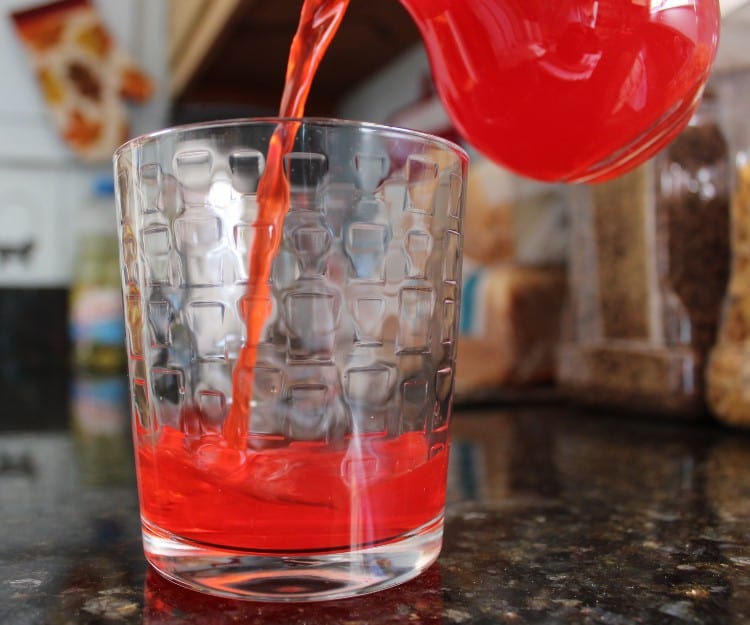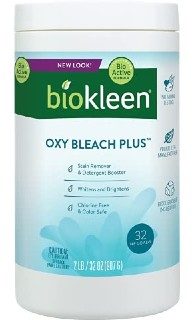Do you have the know-how to get Kool-Aid out of clothes? Are you struggling to remove Kool-Aid stains? How long does it take to remove a Kool-Aid stain? Are there any quick tricks or hacks to stain removal? What should be done if a dry-clean-only garment is stained with Kool-Aid?
Kool-Aid is the beloved drink of children worldwide and the staining bane of our existence. Try cold water and a clean blotting cloth, ice water and Borax, boiling water, laundry detergent and a baking soda paste, vinegar and a denture tablet, Oxiclean, or a steaming iron to remove the stain. The faster you catch the stain, the better the chances of getting it out.
This article provides solutions to Kool-Aid stains and how to approach many other stains! The techniques shown here will help you understand why Kool-Aid stains clothing, which clothes are easier than others from which to remove stains, and even how to get Kool-Aid stains out of the carpet.

Quick Navigation
The Chemistry Behind Stains
Knowing the chemistry behind stains helps you remove them. For obvious reasons, stains have numerous sources. Most stains come from food or spilled drinks, and the type of the food determines the stain’s traits, strength, and color.
Stains are a chemical reaction between the staining substance and another material. This material doesn’t have to be clothing specifically. Wood, walls, concrete, and innumerable others are all affected, but a stain’s nature is always due to a chemical reaction.
Stains happen when the molecules of a staining substance coat a material and become trapped within the fibers, pores, or cells. This coating forms the unsightly stain, bouncing the visible light waves of its distinctive color. For example, when “Hot Red Lipstick” is smeared on a blouse, all colors except for the red light waves are absorbed – and this is the color that we perceive as “Hot Red.”
However, the type of fabric or material can change the color of the stain. If we’re dealing with a natural material like cotton, silk, or wool, the fibers swell with water, and the stain sinks in deeply, resulting in a vivid stain. If the material is artificial, then often water-based substances have minimal effect, while oil-based stains are absorbed.
A material’s origin can also affect the stain’s intensity and hue. This is why Kool-Aid stains natural fibers much deeper than man-made fabrics. It’s also why Kool-Aid is easier to get out of some clothes but not others.
There are three fundamental stains: water-based, oil-based, and dye.
Water-Based Stains:
- Coffee
- Tea
- Blood
- Ketchup
- Jellies and Jams
- Cola
- Fruit Juices
- Milk
Oil-Based Stains:
- Makeup
- Cooking Oils
- Butter and Margarine
- Chocolate
- Salad Dressing
- Deodorant
Dye Stains:
- Kool-Aid
- Food Coloring
- Wood Dye
- Commercial Dyes
Why Dyes Stain Clothes
Dyes are typically transparent with small permeable molecules allowing light to pass through them. A dye can be suspended in oil, water, or alcohol-based mediums. The dyes used on wood products are quite similar to those used for clothing.
Water-based dyes are long-lasting but can fade over time; alcohol-based dyes fade slightly faster, while oil-based dyes tend to fade faster than the others. As Kool-Aid is a water-based dye, you can, unfortunately, expect an effective, long-lasting stain.
How to Approach Stain Removal
Stains are challenging to remove; Mustard, for example, is as infamous as Red Kool-Aid. Mustard sets stains with a multilayered chemical reaction; when you think you’ve got the stain out, it can change from yellow to orange or red. The type of fiber, the nature of the staining substance, and the amount of time the substance has been in contact with your clothes directly affect the removal efforts.
While not listed in the techniques below, DO NOT forget the effectiveness of the average stain remover stick or spray (a worker of miracles in our modern times).
When removing a stain, tackle the process knowing:
- Multiple sessions are likely
- The process may take longer than anticipated
- Fresh stains have the highest chance of removal
Stains require strong solutions such as chlorine, enzymes, oxygenated bleach, or specialty solvents to break up and clear out the stain.
Chlorine bleach and oxygenated bleach either loosen stain particles from fabric by breaking the bonds between the stain and fibers or rendering the stain colorless via oxidation. Oxygenated bleach is safe on whites and colors, whereas chlorine bleach is used on whites only. Oxygenated bleach can be purchased independently or as an ingredient in a detergent, such as OxiClean.
Be aware – all bleaches (color safe or not) may damage garments; please follow all product directions before using.
General Stain Removal Tips & Tricks
- Wet stains are always easier to remove than set stains
- Consider carrying a stain stick in your purse or car so stains can be pretreated expeditiously.
- Use a proper blotting technique to remove the excess stain (never rub or scrub) before rinsing the area with cool water.
- Never put a stained garment in the dryer until certain the stain is gone. Otherwise, the dryer will set the stain, making it permanent.
How to Get Kool-Aid Out of Clothes

ATTENTION: Is your garment dry-clean only? You’ll want to check your garment tag if you’re unsure. These techniques can shrink, stretch, or damage dry-clean-only clothes.
If your garment is dry-clean-only, please take it to a professional cleaner, show them the location of the stain, and inform them that it’s a dye stain. In this case, a professional is best equipped to remove these stains. If your garment isn’t dry-clean-only, please continue with the seven techniques listed below.
Cold Water
Working while the Kool-Aid stain is still wet, blot as much of the stain as possible using a paper towel or clean rag. Then turn the garment inside out and place it under the faucet running cold water through the stain.
You want to do this inside-out, as the flowing water forces the Kool-Aid back out rather than pushing it further into the fabric. Rinse for a full minute, then turn the garment right-side-out and resume blotting. Repeat this process until the stain is gone. You can also try rinsing the stain with club soda, seltzer water, or even 7up soda, as carbonization can disrupt the dye, assisting with removal.
Pro Tip: Blot, don’t scrub. Blotting applies downward pressure with a clean rag, cloth, or paper towel. Repeated blotting is advised, as this lifts stains while scrubbing/rubbing spreads stains—work first from the outer limits of the stain, moving toward the center.
Ice Water/Borax
 Carefully blot the stain continuously as you use this technique. Fill a spray bottle 2/3rds full of ice and top off with water. Spray the stain liberally with ice water, then sprinkle with borax.
Carefully blot the stain continuously as you use this technique. Fill a spray bottle 2/3rds full of ice and top off with water. Spray the stain liberally with ice water, then sprinkle with borax.
Immediately press the borax into the stain using the proper blotting technique (don’t rub or scrub). Spray, apply borax, and repeatedly blot until the stain is removed. Please don’t use a toothbrush or rub the garment against itself, as this will spread the stain instead of removing it.
Once the stain is gone, allow the garment to air dry.
Pro Tip: Allow all garments to air dry completely as a light stain may go unnoticed until fully dry.
Boiling Water
This technique works best on fresh stains but can also have surprising results on dry stains. Avoid boiling the water in a pan, as pans aren’t known for pouring precisely. It’s better to boil water using a tea kettle, allowing pinpoint accuracy. Pouring boiling water can be dangerous; please be safe and use your best judgment.
Place a large bowl in your sink, then position the garment in the bowl with the stain centered. Carefully pour the boiling water through the stain for immediate results.
Sometimes, this clears the stain in one go, and other times, it has minor results; either way, you should see the stain lighten. Let the garment sit for 30 seconds, then remove it from the bowl using tongs.
Repeat this process as necessary until the dye is removed. Rinse the garment with cold water and allow it to air dry.
Pro Tip: Never put stained clothing in the dryer as the heat will set the stain. Instead, place it on a hanger to air dry or pin it to a clothesline.
Laundry Detergent/Baking Soda
 Blot up as much of the stain as possible, then pour liquid laundry detergent on the stain. Let the detergent rest for ten to twenty minutes, then rinse with cold water. There will likely still be a faint stain remaining; using baking soda and water, create a paste and aggressively blot it into the stain.
Blot up as much of the stain as possible, then pour liquid laundry detergent on the stain. Let the detergent rest for ten to twenty minutes, then rinse with cold water. There will likely still be a faint stain remaining; using baking soda and water, create a paste and aggressively blot it into the stain.
Let the baking soda rest for ten to twenty minutes, then rinse with cold water. Hand wash the garment in the sink using cold water, then hold it up to the light. If you see no stain, you’re done; if not, repeat these steps until removed.
Pro Tip: Kool-Aid is a very effective dye stain (especially the red varieties). Act quickly if the stain is still wet. Your chances of getting it out are much higher.
Vinegar and Denture Tablet
 Using either ammonia, white vinegar, or rubbing alcohol, spray directly on the stain (Never mix these chemicals; choose ONE and stick with it.) and aggressively blot with a clean rag. Rinse the garment in cold water and repeat. This may not entirely remove the stain, but at minimum, it should lighten it significantly. Next, dissolve some denture tablets in a bowl of water and soak the garment overnight. Rinse with cold water and hold the affected area up to the light; if the stain remains, repeat the process until resolved.
Using either ammonia, white vinegar, or rubbing alcohol, spray directly on the stain (Never mix these chemicals; choose ONE and stick with it.) and aggressively blot with a clean rag. Rinse the garment in cold water and repeat. This may not entirely remove the stain, but at minimum, it should lighten it significantly. Next, dissolve some denture tablets in a bowl of water and soak the garment overnight. Rinse with cold water and hold the affected area up to the light; if the stain remains, repeat the process until resolved.
Pro Tip: Always test your stain removal technique on a hidden part of the garment to ensure it won’t cause damage.
Oxygenated Bleach or OxiClean
 Oxygenated bleach is not the same product as Clorox, chlorine, or straight bleach; it’s safe to use on natural or synthetic colors and whites. If you’ve already tried the techniques above and haven’t removed the stain, this one should do the trick.
Oxygenated bleach is not the same product as Clorox, chlorine, or straight bleach; it’s safe to use on natural or synthetic colors and whites. If you’ve already tried the techniques above and haven’t removed the stain, this one should do the trick.
If you don’t have oxygenated bleach, use OxiClean (using the same measurements and time indicated). Add ¼ cup oxygenated bleach to a small bucket of warm water. Soak the garment for four to eight hours, then hand-wash it in your sink with a bit of laundry detergent. As usual, air-dry the garment and check for any remaining stain or residue. Repeat if necessary.
Pro Tip: Despite the internet rumors, adding Aspirin to a soak will do nothing to remove stains. Aspirin + Water = Salicylic Acid, which has no stain-fighting properties; it’s more an anti-inflammatory and exfoliant.
Steaming Iron
This technique is the last resort; it works on fresh, set, and even old carpet stains. While this technique is very effective, it also has the most potential to damage your garment, the carpet, and you. Please proceed with caution; children should never attempt this; this is an adults-only method.
Arrange the stained garment center to the ironing board. Ensure your iron is full of water and set to medium heat with steam enabled. Using a spray bottle, liberally apply a 50/50 ammonia-to-water solution.
Cover the garment with a small clean towel soaked in hot water; it shouldn’t be dripping wet but should be very damp. Place the steaming iron on the damp towel making circular motions for thirty seconds over the stained area.
Keep the iron in motion to avoid burning the towel or the garment beneath. Don’t press down on the iron; allow the weight of the iron to do its job. After thirty seconds, lift the iron and inspect the towel and garment.
You’ll notice the stain has lifted through the garment and transferred into the towel. Repeat the steaming process as necessary until the stain is gone. Hand-wash the garment in your sink using laundry detergent.
Allow the garment to air dry and check for any remaining stain.
Pro Tip: Try a combination of techniques shown here if you experience minimal results.
Kool-Aid Dye
Kool-Aid is a dye. If you can’t get the stain out at the end of the day, you might consider using Kool-Aid to dye the garment the color of your choice. This method is affordable and is a fun project to do with children.
Soak your garment in a bucket of water for thirty minutes before preparing the Kool-Aid dye. Using a pot, bring four to six cups of water to a rolling boil, then reduce the heat to a simmer and add the (unsweetened) Kool-Aid color of your choice; the red varieties tend to last the longest. The more packets used, the heavier or darker the color of the garment.
Don’t mix and match packets, as this will create a muddled dye. Choose one color and stick with it. One packet will have light results, while three packets should be reasonably dark.
Add ¼ cup of distilled white vinegar to the solution and stir. The vinegar is a crucial ingredient as it will microscopically etch the fibers allowing the dye to penetrate deeper. Remove the pan from the heat and immediately place the garment in the dye, stirring until thoroughly soaked.
Let the garment rest in the Kool-Aid dye until cool, then rinse with cold water and allow to air dry.
Pro Tip: Use it while it’s hot! A heated Kool-Aid dye is far more effective than using it cold. Remember, Kool-Aid dye works best on natural fibers like cotton, wool, linen, and silk. Using synthetic materials will yield temporary or poor results.
A Brief History of Kool-Aid
In 1927, in Hastings, Nebraska, an enterprising man by the name of Edwin Perkins invented Kool-Aid. Edwin already had a successful line of concentrated juices known as “Fruit Smack,” which was sold in corked bottles, and he wondered if he could simplify the process, thereby saving money on shipping costs. Edwin created Kool-Ade (later renamed Kool-Aid) shortly after being introduced to the powdered product “Jell-O.”
Kool-Aid has always been affordable, it sold for ten cents a package, and unlike many products, demand for Kool-Aid actually grew during the Great Depression. Edwin cut the cost of Kool-Aid from ten cents to five cents to make it even more affordable. He also included small toys and cardboard cutouts for wider child appeal.
Edwin eventually received a government contract to include lemonade Kool-Aid packets in World War II ration kits. This made Kool-Aid a recognizable product known worldwide.
The original Kool-Aid flavors were: lemon-lime, grape, cherry, raspberry, strawberry, orange, and root beer! To this day, each Kool-Aid packet has a unique color and minor ingredient differences. Every color, especially the red varieties, can stain surfaces and clothes deeply. In the event of a spill, you’ll want to act quickly.
Conclusion
We wish you luck in your stain removal adventures. Remember to approach the process with patience knowing multiple sessions are likely. If one of the above techniques doesn’t work, try the next one or develop a series of techniques that works for you. Share your findings in the comments! I hope this article was valuable to you. Please comment if you have any questions and share this article with your friends!